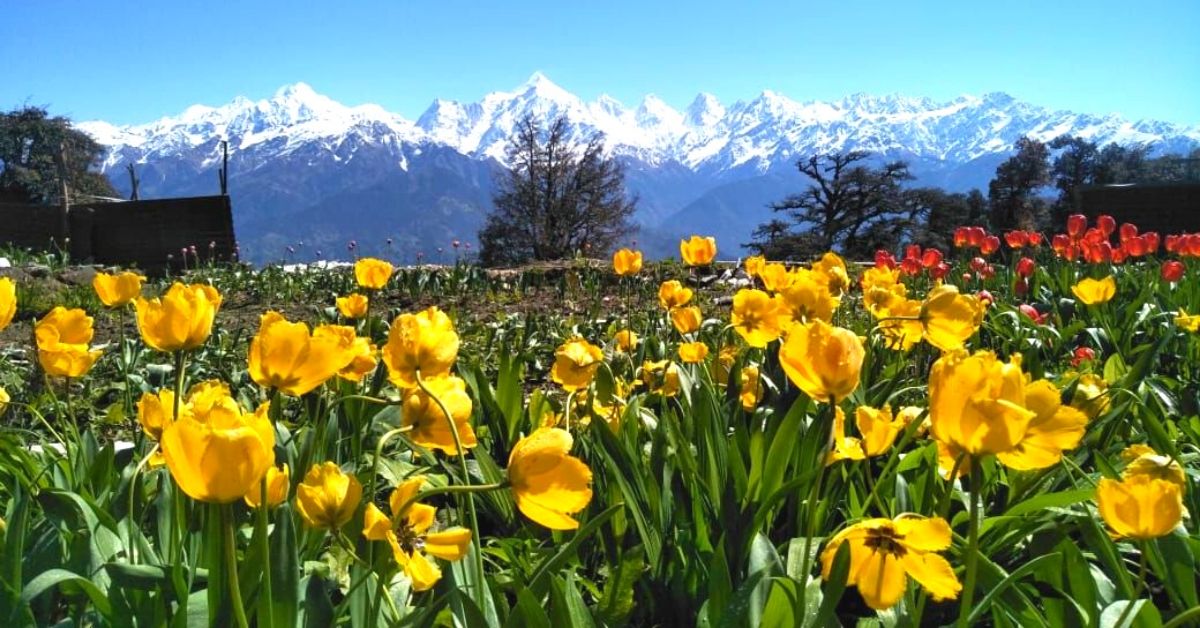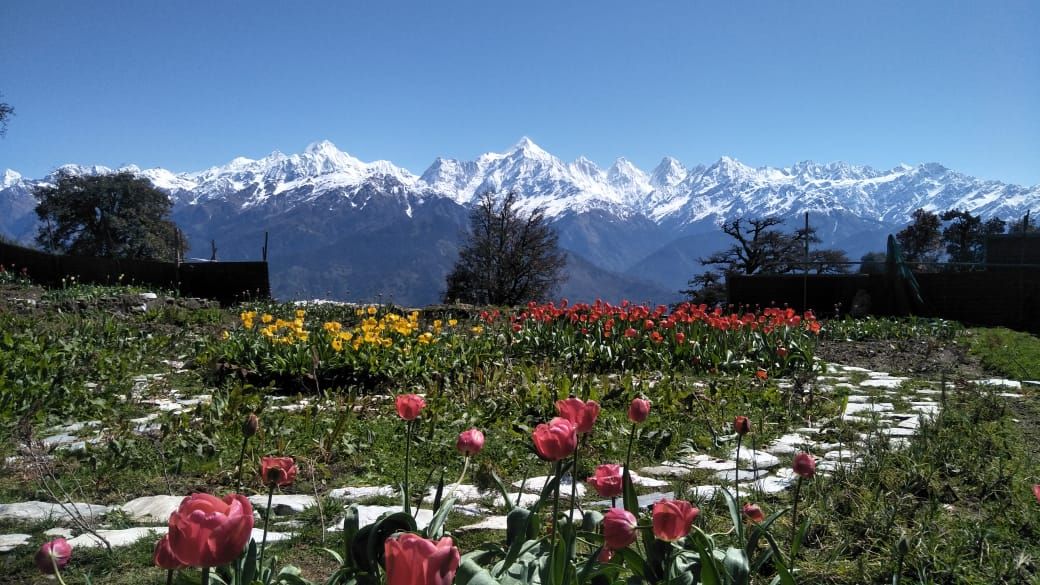IFS Officer & 2K Villagers are Turning Barren Land into World’s Largest Tulip Garden
The success of Tulip gardens like these can ensure border districts like Pithoragarh in Uttarakhand can offer the necessary economic incentives for people not to migrate and strengthen their own region.

With the Panchachuli peaks, a group of five snow-capped Himalayan mountains, situated at the eastern end of the Kumaon region providing the ideal backdrop, the picturesque township of Munsiyari in Uttarakhand’s Pithoragarh district feels like heaven on earth.
These days, the hill township and its adjoining villages are in the spotlight because of the tulip garden situated along the Thal-Munsiyari state highway.
Envisioned by Dr Vinay Bhargav, Divisional Forest Officer, Pithoragarh, this tulip garden is expected to stretch over 50 hectares. It is part of a larger Munsiyari Nature Education and Eco Park Center, which seeks to attract a plethora of tourists, students and nature lovers who want to witness the various flowers of this scenic region in all its beauty.
Although designed by Dr Bhargav, the real workforce behind this garden are the members of Munsiyari Eco-Development Committee (EDC) comprising largely unemployed local community youth involved in the development of the facility from inception to completion and its maintenance. Local residents are involved right from soil work, site preparation, planting and irrigation to the nurturing process, protection and monitoring of this garden.
The same set of people is also involved in knowledge dissemination, and now act as resource persons for local villagers and tourists who want to engage in a similar endeavour. Presently, the carrying capacity of the site is fixed at 300±50 persons per day and one day of the week it is closed to all visitors. Although the COVID-19 epidemic has put a dampener on proceeding this season, the Munsiyari EDC hopes that next year tourists can grace this site.

Why was this particular site chosen?
The region witnesses massive snowfall and frost during winters followed by long cool springs and occasional rain in summers. Everything from the physio-graphical features viz. elevation (2760 mts. above msl), moisture availability, well drained soil conditions and gentle slopes to ideal ambient temperatures (18 to 25 degree Celsius) and soil pH levels found to be between 6.0 to 7.0, are perfect for growing tulips.
“Meanwhile, the topography of the area is such that north-east facing slopes of the landscape, where the tulips have been planted, will ensure relatively better moisture availability. Complete sunshine from all sides made the site suitable and perfect for tulip growth,” informs Dr. Bhargav.
Early Struggle, Challenges & In Bloom
“The site selected for this pilot project was initially infested with a weed commonly referred to as jangli paalak (Rumex nepalensis). It has a deep root system and can regenerate itself from the slightest of leftover parts that remain in the soil. In fact, it has been creating massive problems in almost all of the Himalayan sub-alpine and alpine areas by encroaching upon the native herbaceous and shrub species,” says Dr Bhargav, in an interaction over email with The Better India, earlier this week.
Consequently, a massive exercise was undertaken in October 2018 by the Munsiyari EDC to completely eradicate this weed using basic garden implements. Certain landscaping and improvement in the aesthetics like paths and trails development were also done.
For the purpose of developing demonstration blocks at Munsiyari, 7000 high quality tulip bulbs, in five colors across seven varieties — Carola (Pink colour), Crystal Star (Yellow colour), Denmark (Yellow-Red colour), Jumbo Pink (Pink colour), Parade (Red colour), Strong Gold (Yellow colour) and White Proud (White colour) were imported from the Netherlands for planting on the pilot site.
However, due to multiple reasons, there was an apparent delay in getting the bulbs, and they only arrived in the last week of March 2019. Although it was not the appropriate time to plant them, the EDC went ahead and did that.
After the snow melted on the pilot site by March end, the next step was to augment soil fertility and prepare the demonstrative blocks made up of raised soil beds to plant tulips and other native species in the first week of April.
“For this, we used a mixture of oak forest soil, farmyard manure and cocopeat in a 1:1:1 ratio, The bulbs and other native species were planted by the members of the Munsiyari EDC. Vegetative growth took around 45 days, after which the site had witnessed intermittent blooms,” he says.
These bulbs went through several stresses during the past year of planting, particularly after the monsoon season. By this time, the bulbs remained in soil and the foliage had started to wither away with the onset of winter in November 2019. The bulbs remained in the soil and witnessed the severe winter of 2019. Although the pilot site remained under snow for more than three months, Dr Bhargav and the EDC were convinced that the Tulip bulbs still had life in them, and proceeded to protect them from field rats, wild boars and Langurs with fencing work around it.

“After the snow melted in March 2020, foliage started to develop back in April 2020. These tulips did bloom intermittently, but they were still at a premature stage. This wasn’t the end of their troubles. Despite the onset of spring, there was a sudden spurt of hail storms, but the Tulips somehow managed to withstand them. As the foliage grew back in strength, we began to witness the sparkling bloom of these tulips in a variety of pink, white, red and yellow. Other wild species of Irises, Ranunculi, Fox gloves also went into bloom around the same time, but bloom of the tulips stole the show,” says Dr. Bhargav.
All the planted bulbs fared well. The site enjoyed 100% success in germination and yielded the desired results. Besides these, they had also planted with them other native wild ornamental flowering species including Irises, Fox Gloves, Rhododendrons, Wild Roses, Liliums, Daffodils, Dogtails, Ranunculi etc., but tulips were the most attractive species of them.
“The core idea was to strengthen the eco-restoration work of previously invaded weed sites in Himalayan subalpine areas, and improve the biodiversity wealth of the area,” he adds.
Thanks to these ideal climatic conditions and the successful planting process, each mature bulb of a tulip has now produced 6-8 daughter bulbs. In order to cut down on repetitive buying expenses on import, the Project has also envisaged developing a technology with due technical support from Dutch partners to process and develop mature bulbs from these daughter bulbs.
Economic Potential
The larger objective behind developing the tulip garden is to boost the sylviculture, horticulture and tourism sector in the state that would provide additional opportunities for sustained rural self-employment. The government believes that landmark projects like these could go in some way to concurrently mitigate the challenges of outward migration from these hills.

How is this happening? What’s the potential?
1. The development of the facility from inception to completion and its maintenance can be credited to the local community. They were thoroughly involved right from soil work, site preparation, planting, irrigation, nurture and care, protection, monitoring activities, etc.
2. Under the aegis of the State forest department and active consent of the EDC, large scale cultivation of tulip bulbs will be undertaken on community lands and on fallow lands of people who have migrated from hill regions of Munsiyari. In other words, all land left barren or uncultivated will receive a new lease of life. Also, the farmers are encouraged to practice floriculture/ horticulture based farming to enhance their earnings.
3. These people are also involved in knowledge dissemination, and now act as resource persons for local villagers and visitors who wish to emulate this initiative. Local residents have even helped execute the work of thermal insulated and disaster proof state of the art alpine Eco-huts near this site. This is a one of a kind structure.
4. “The site also hosts a wide variety of birds of different species (approximately 250), which also opens the potential for Bird tourism. The site also reflects the remarkable effect of ecotones on the flora and fauna diversity in the region. As regard to beneficiaries, upon full scale implementation of the Project, around 1,500 to 2,000 people from the surrounding villages will be engaged in direct/in-direct employment for cultivation, maintenance, eco fee collection and other ancillary activities,” claims Dr. Bhargav.
5. “Furthermore, as upscaling of the project is envisaged, it will demand many direct and indirect support systems like local and distant transportation facilities, promotion of home stays, village tourism, bird tourism, comfortable accommodation in terms of hotels, resorts, paying guest houses, local market to meet out different needs of the tourists, traditional commodities and culture besides Tulip garden management needs (in terms of manpower and inputs),” he says
The success of projects like these can ensure border districts like Pithoragarh can offer the necessary economic incentives for people not to migrate and strengthen their own region. It may not completely stop the migration process, but it can go some way towards at least mitigating it. Admittedly, the Coronavirus pandemic this year has put a dampener on proceedings, but its potential for the future is great.
(Edited by Gayatri Mishra)
Like this story? Or have something to share? Write to us: [email protected], or connect with us on Facebook and Twitter.

Similar Story

Road to UFC: How an Ex-Math Tutor From Uttarakhand Became India’s Best MMA Fighter
Anshul Jubli, the 27-year-old professional athlete from Uttarakhand, is on the cusp of becoming the second Indian-born MMA (Mixed Martial Arts) fighter to earn a contract with the UFC (Ultimate Fighting Championship).
Read more >
If you found our stories insightful, informative, or even just enjoyable, we invite you to consider making a voluntary payment to support the work we do at The Better India. Your contribution helps us continue producing quality content that educates, inspires, and drives positive change.
Choose one of the payment options below for your contribution-
By paying for the stories you value, you directly contribute to sustaining our efforts focused on making a difference in the world. Together, let's ensure that impactful stories continue to be told and shared, enriching lives and communities alike.
Thank you for your support. Here are some frequently asked questions you might find helpful to know why you are contributing?


This story made me
-
97
-
121
-
89
-
167












